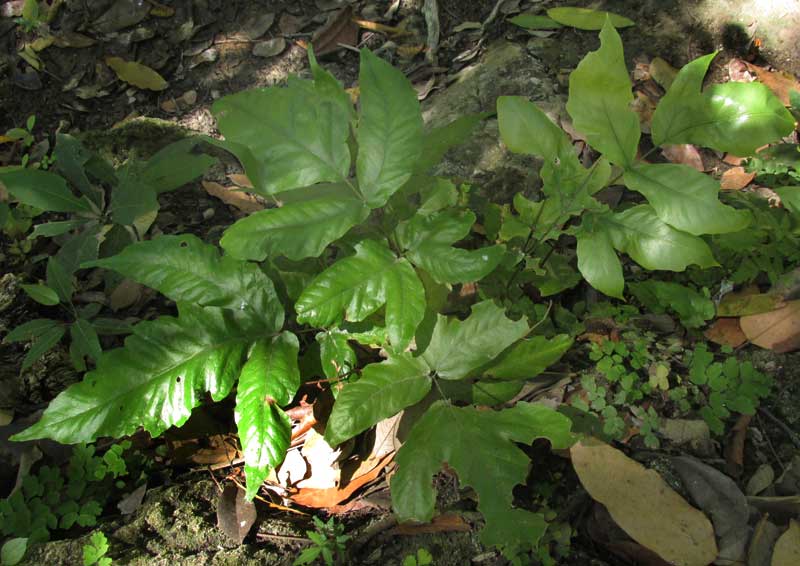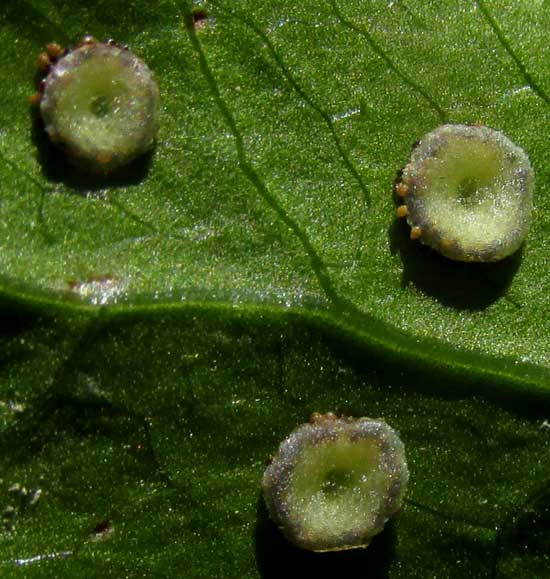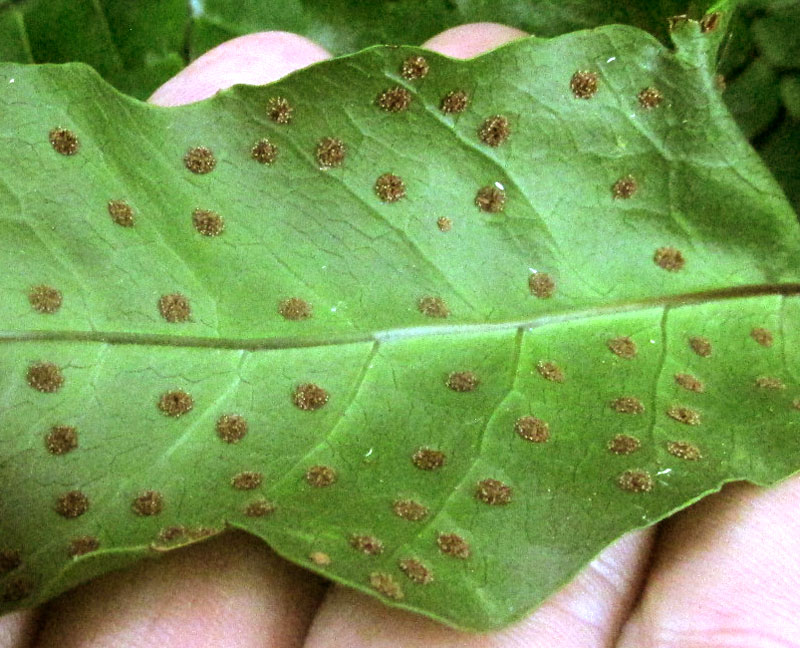Excerpts from Jim Conrad's
Naturalist Newsletter
from the April 9, 2017 Newsletter, a special on-the-road edition with notes from Micos Cascades on the Río Salto maybe 30kms northwest of Ciudad Valles in the state of San Luis Potosí, elevation ~140m (560ft), MÉXICO; (N22.09962°, W99.14798°)
JAPANESE HOLLY FERN IN MEXICO
Last week, travelling by bus up through Mexico to Kentucky, at Micos Cascades on the Río Salto maybe 30kms northwest of Ciudad Valles in the Mexican state of San Luis Potosí, a certain fern caught my attention. It was fairly common on limestone rock and hard-packed mud right at the rushing water's edge. One fern about two feet across (70cm) is shown below:

You can see that the fern's leathery fronds are pinnately compound, and that the leaflets, or pinnae, display wavy to slightly toothed margins. The fronds' stems, at least toward their bases, are blackish. This fern species definitely is not a frilly looking or delicate one. In fact, I wasn't absolutely sure that it was even a fern until I flipped over a frond and saw widely spaced, round, spore-producing fruit-dots, or "sori," shown below:

Those sori are worth examening, as you can see up close below:

In most fern species with sori on the fronds' undersurfaces, the sori are long or, if they're roundish, they don't look like this. In the above picture, the doughnut-shaped sori are composed of two main parts. First, there's the pale-yellowish-green, ring-shaped "indusium." Most sori indusia are long, thin flaps of tissue with one side attached to the blade while the other side opens so that those tiny, brown, seed-like things can emerge from the resulting slit. Here the indusia are circular and attached at their center -- they're "peltate." That's really interesting. The tiny, brown things along the margins are stalked, baglike sporangia, with each sporangium containing several dust-like spores. When the sporangia are mature they burst, release their spores into the wind, and the spores will be carried to a new location where, if environmental conditions are just right, they'll germinate. To get all these terms better fixed in your mind you may want to look at our Fern Page at www.backyardnature.net/ferns.htm.
Our pictures show the Japanese Holly Fern, CYRTOMIUM FALCATUM, native to eastern Asia, but in the wild growing from rock crevices, on coastal cliffs, streambanks, rocky slopes -- all in fairly moist places. It's on a streambank in Mexico, as well as similar environments in most of the rest of the tropical and subtropical world, because it's become a popular ornamental plant that sometimes escapes into the wild. Apparently the plants I found were either just getting established, or not in an environment entirely to their liking, because pictures of the species on the Internet show larger plants with fronds divided into more numerous pinnae. The Flora of North America says the pinnae can arise in up to twelve pairs, and that the fronds can reach over a meter in length (over three feet). The Flora also describes the species as "apogamous," meaning that its embryo can develop without fertilization having taken place -- which might be one reason this fern species has become so weedy.
entry from field notes dated October 6, 2022, taken along the main road on the northern side of Gómez Farías, on the lower eastern slope of the Eastern Sierra Madres, El Cielo Biosphere Reserve, southern Tamaulipas state, MÉXICO; elevation about 350m (1150 ft), ± LAT. 23.04°N, LONG. -99.15°W
JAPANESE HOLLY FERN SORI WITHOUT INDUSIA

In the shaded understory of a disturbed forest on a steep slope beside the road about 1.5km north of Gómez Farías's town park, invasive Japanese Holly Fern turned up in a thicket of Diamond Maidenhair fern, Adiantum trapeziforme, as seen at the right. As with the fern in the previous entry, this one bears only a few pinnae, while on the Internet the vast majority of pictures show individuals with numerous ones. Probably the Internet pictures are mostly of potted or nursery-grown plants, or of those growing under more optimum conditions.
If you try to "key out" the plant in our picture you may go wrong when you see the sori, shown below:

Those are mature sori showing no hint of indusia. Sori of the fern profiled at the top of this page were covered with conspicuous indusia. In this species, the indusia are "caducous," meaning that as the sori mature the indusia wither away. I suspect that in the above picture the tiny white, worm-shaped items widely scattered among the sori are withered, curled-up indusia broken away from their sori.
Another identification error one might make with this species is that another fern occurring in upland northern Mexico, the Mexican Holly Fern, Phanerophlebia auriculata, can look very similar to our photos, and have their frond undersurfaces peppered with round sori without indusia. However, that species' pinna veins are straighter and much closer together, and the pinna margins tend to be fine-toothed, not toothless as in this species.